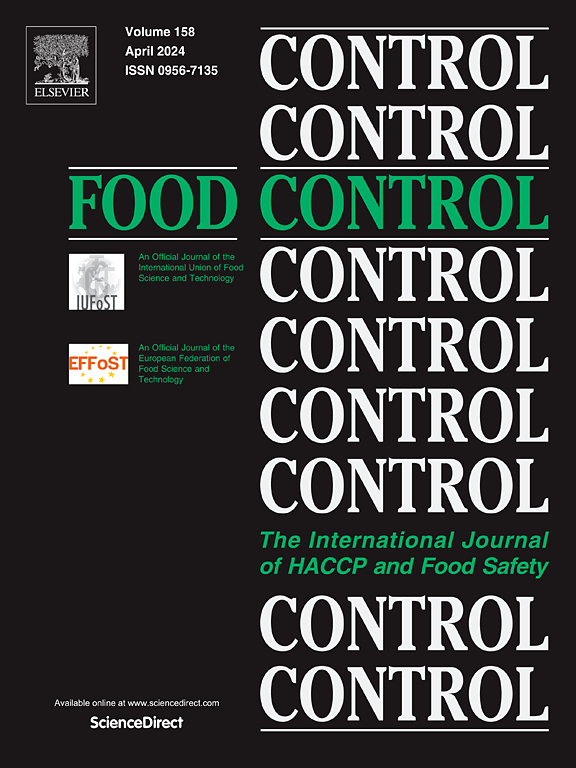Application of high-hydrostatic pressure to extend shelf life of miso-marinated escolar loins during cold storage
IF 5.6
1区 农林科学
Q1 FOOD SCIENCE & TECHNOLOGY
引用次数: 0
Abstract
The changes in the microbiological and chemical qualities of escolar meat following high-pressure processing (HPP) (300–600 MPa, 5 min) along with miso marinade for 15 days with refrigeration were evaluated. Miso marinade and HPP treatment of escolar meat had synergistic inactivating effects on microorganisms that were more pronounced at higher pressures. In addition, when stored at 4 °C, the combination of miso marinade and HPP treatment significantly delayed microbial growth and total volatile basic nitrogen (TVBN) production and inhibited pH changes. Using TVBN <25 mg/100 g as the criterion for freshness, miso marinade and HPP treatment (300–600 MPa) extended the refrigerated storage period from 3 days without treatment and 6 days with miso marinade alone to 15 days. In addition, high-throughput sequencing analysis showed that the combination of miso marinade and HPP treatment significantly altered the microbiome of the fish during refrigeration, thereby slowing the spoilage process. This study demonstrated that miso marinade along with HPP treatment can improve color and texture, inhibit microbial growth, delay quality deterioration, and prolong the shelf life of fish meat. Therefore, high pressure together with miso marinade is an effective hurdle technique for improving the quality and freshness of aquatic products.
应用高静水压延长冷藏期间味噌腌制鲈鱼里脊的货架期
研究评估了经过高压处理(HPP)(300-600 兆帕,5 分钟)和味噌腌制(冷藏 15 天)后的鱼肉微生物和化学品质的变化。味噌腌泡汁和 HPP 处理对鲱鱼肉具有协同灭活微生物的作用,这种作用在压力较高时更为明显。此外,在 4 °C 下贮存时,味噌腌泡汁和 HPP 处理的组合可显著延缓微生物的生长和总挥发性碱氮(TVBN)的产生,并抑制 pH 值的变化。以 TVBN <25 mg/100 g 作为新鲜度标准,味噌腌泡汁和 HPP 处理(300-600 MPa)可将冷藏贮藏期从未加处理的 3 天和单独使用味噌腌泡汁的 6 天延长至 15 天。此外,高通量测序分析表明,味噌腌泡汁和 HPP 处理的组合在冷藏期间显著改变了鱼的微生物群,从而减缓了鱼的腐败过程。这项研究表明,味噌腌泡汁与 HPP 处理相结合可改善鱼肉的色泽和质地,抑制微生物生长,延缓鱼肉品质恶化,延长鱼肉的货架期。因此,高压和味噌腌制是提高水产品质量和新鲜度的有效方法。
本文章由计算机程序翻译,如有差异,请以英文原文为准。
求助全文
约1分钟内获得全文
求助全文
来源期刊

Food Control
工程技术-食品科技
CiteScore
12.20
自引率
6.70%
发文量
758
审稿时长
33 days
期刊介绍:
Food Control is an international journal that provides essential information for those involved in food safety and process control.
Food Control covers the below areas that relate to food process control or to food safety of human foods:
• Microbial food safety and antimicrobial systems
• Mycotoxins
• Hazard analysis, HACCP and food safety objectives
• Risk assessment, including microbial and chemical hazards
• Quality assurance
• Good manufacturing practices
• Food process systems design and control
• Food Packaging technology and materials in contact with foods
• Rapid methods of analysis and detection, including sensor technology
• Codes of practice, legislation and international harmonization
• Consumer issues
• Education, training and research needs.
The scope of Food Control is comprehensive and includes original research papers, authoritative reviews, short communications, comment articles that report on new developments in food control, and position papers.
 求助内容:
求助内容: 应助结果提醒方式:
应助结果提醒方式:


